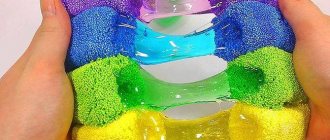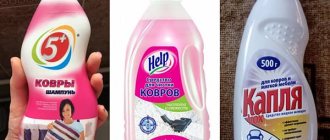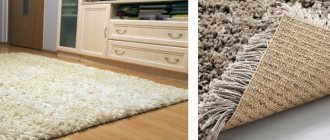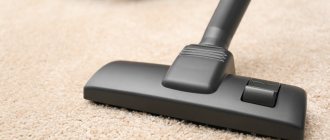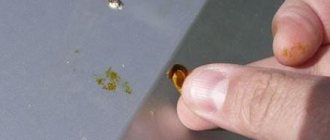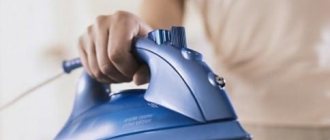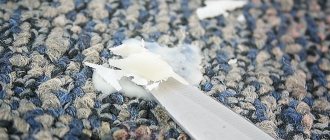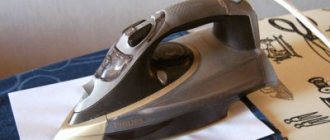A beautiful and stylish carpet plays not only a decorative role in interior design - it helps to make the room more comfortable, harmonious and warm. Of course, every child likes to play on a soft floor, but the consequences of such games can be quite disastrous: difficult to remove stains, marks from felt-tip pens, pens and other dirt.
It seems the most difficult and difficult to remove plasticine from the carpet at home. As a rule, many people try to clean traces with specialized means: “Vanish”, “Antipyatnin” and others. In fact, foam products are ineffective against classic plasticine and in order to completely remove it, a number of measures will be required.
Of course, before removing plasticine it is worth remembering that:
- do not use sharp objects to remove it from the fibers;
- stain removers containing chlorine can “blur” the pattern on the product;
- after wet cleaning, the product should be thoroughly dried in a warm and sufficiently ventilated room to avoid the occurrence of unpleasant odors;
- You should not try to remove several traces at once. With large areas of dirt, it is almost impossible to clean the carpet from plasticine (especially from delicate fabrics), so it is better to trust the professionals;
- you should not use several specialized means at once, so as not to provoke their reaction;
- All products can be used only after a preliminary test on an inconspicuous area of the product.
It is also worth making sure that there are no children or pets in the room at the time of all work, as well as people suffering from allergic reactions.
How to remove plasticine embedded in a carpet: methods
All methods for removing plasticine can be divided into simple folk and harsh chemical ones (this is heavy artillery). The key idea is to preserve the carpet fibers and work on the plasticine structure. Potent drugs contain acids and alkalis, they must be used carefully. A selection of proven and effective methods looks like this:
- vinegar with salt and powder (applied to a sponge and rubbed into the affected surface);
- soap solution;
- thermal effects (heat and cold);
- car cleaners (proven to be excellent);
- rough mechanical techniques.
If the plasticine has not yet dried, it can be removed in several stages:
- attach a bag of ice to it (you can also use snow) so that the consistency hardens;
- after hardening, it is worth removing the plasticine from the carpet using the blunt end of a knife (or a special plastic knife, which is often included with regular plasticine);
- treat the pile with a specialized product or one of the products suggested below.
After most of the plasticine is removed, there is often a slightly greasy residue left. To remove it, you can use one of the most accessible means:
- ammonia, which should be used to moisten a cotton pad and carefully walk over the stain;
- specialized white spirit is a universal solvent that can be used on light-colored carpets (also applied to a disc or clean cloth);
- gasoline (as with other solvents, it should be handled very carefully);
- laundry soap (soap up the stain and rinse carefully with cool water).
In addition, you can remove plasticine from the carpet with a specialized car interior cleaner. As a rule, it is applied for 20-40 minutes, and then the area of contamination is wiped with a clean microfiber cloth. If necessary, it is worth repeating the procedure.
We offer you several ways to remove plasticine from carpeting.
Cooling
If it’s cold outside, you can take the rug out onto the balcony and wait until the stain freezes well. After this, we scrape off the hardened plasticine using a nail file.
If the rug was dirty in the summer, then you will need ice to clean the rug. The ice is folded into a bag, the air is released and tied into a knot. After this, it is placed on the stain and left for about thirty minutes. After this, the plasticine will begin to crumble. After this, you pick out the bulk of the mass, and clean off what is left with a brush. Don't forget to vacuum the area where the stain was afterwards.
If after cleaning there are greasy marks left, which, by the way, happens very often, take a little cotton wool moistened with alcohol. Rub the stain gently until it is completely gone.
If the plasticine has already been stretched over the carpet, then ice is definitely not enough. To do this, iron the stain through the fabric. The stain must be ironed several times until the entire piece remains on the fabric. Change shreds as needed. After this, wipe the stain with alcohol.
Vegetable oil
Vegetable oil does a good job of removing stains, but afterwards it is necessary to wash the area where the manipulations were carried out. You can wash off any remaining vegetable oil using liquid soap.
To remove plasticine using vegetable oil, you need to remove as much of the mass as possible. After this, apply vegetable oil to a cloth and wipe the stain with it. The plasticine will begin to roll and can be easily removed by vacuuming the rug. Then wash the area where the stain was removed so that no greasy trace of vegetable oil remains.
Petrol
You can remove dirt stains using gasoline, alcohol, ammonia, or nail polish remover. But this method has one big disadvantage - an unpleasant odor that will persist in the apartment for quite a long time.
If you decide to use this particular method, then first you need to remove children and pets from the room, and only then begin removing the contamination.
First, test the product on a less noticeable area so that the carpet does not change color after the work. After this, you can safely start working. Using a cloth, apply the product to the damaged area and leave for 5 minutes.
After this, use a dry sponge to remove the sticky mass. Then we remove the residue using a soap solution.
IMPORTANT! Do not forget that after the manipulation it is necessary to rinse the carpet with water.
General recommendations
Before we tell you how to clean plasticine from a carpet, let's figure out what this sticky substance consists of. Basically, plasticine is made from purified clay powder with the addition of wax, various fats and dyes. Thanks to its fatty, oily components, this material does not dry out and adheres well to any solid base. Therefore, it is not enough to simply peel off the plasticine. You will have to work harder to remove the greasy stain that it left behind.
The situation will become more complicated if the plastic material had a bright color. Then the greasy stain will also be colored, and you will have to deal with it using the necessary stain removers. In any case, plasticine from the carpet must be cleaned immediately as soon as it is discovered, before it is trampled on and it does not stick into the thickness of the pile.
There are several ways to remove plasticine. Using freezing and vice versa, heating (melting at high temperatures). You can choose the required method only by studying the composition of the material, in this case the carpet pile. The coating, which consists of 100% synthetic materials, should not be heated too much, as the material can easily melt and instead of a small plasticine spot, you will get a large hole. Those carpets that can withstand the low temperature of the iron can be cleaned using the heating method.
In order not to make a mistake in choosing a method, just read the tag or label that comes with the product. If it is not there, you can try ironing an inconspicuous small edge of the carpet with an iron. If the pile has not changed its structure, then you can use this method, but if you have any doubts, do not take risks and use the freezing method. Remove ice cubes or a bag of frozen food from the freezer. Place it on top of the plasticine. Wait until the plastic mass has completely hardened (it may take about 20 minutes). Then, using the blunt side of the knife, carefully scrape it away from the carpet. Since plasticine is based on wax, it is enough to freeze it well so that it begins to crumble into small pieces.
The hot method is to melt the plastic mass. To do this, we need an iron, the steam function is not needed, and paper napkins or towels. To clean plasticine, you need to set the temperature of the iron to the appropriate temperature for the carpet material. Place a napkin folded in several layers on top of the plasticine stain and apply an iron to it. Do this carefully, do not lean the entire sole down, work with the edge of the iron (its nose).
At high temperatures, the plasticine will quickly melt and absorb into the paper. Soiled napkins must be replaced with clean ones and the procedure repeated until all the plasticine mass has disappeared from the carpet. Some housewives prefer to clean plasticine not with an iron, but with a hairdryer. The principle is the same, you need to completely melt it and clean it off the carpet.
Of course, after such cleaning, there will still be a visible greasy stain on the carpet, and if the plasticine was colored, you will have to try to remove the coloring pigment.
How to remove plasticine from a carpet - first steps
You can also try to scrape off old pieces with non-sharp objects, but if this does not give any result, then you can try the following method:
- Place a clean sheet of notebook onto the plasticine stain (no ink; newspapers will also not work);
- turn on the iron at low temperature and iron carefully;
- change the paper as it becomes “fat” with plasticine.
However, it is worth noting that it can only remove plasticine from a carpet if the carpet is made of natural fabrics or when using very low temperatures. It is also recommended to cover the carpet with a cloth around the paper to preserve the pile.
There is another option, but it is only suitable for carpets with rough pile - try to clean the plasticine using a solvent or acetone-containing preparations. It is worth noting that this aggressive method should only be used if there is no risk of damaging the product.
So, you noticed that your carpet is stained with plasticine. What to do first? Do not immediately rush for a brush and vigorously scrub the stain. In some cases, this can only make the situation worse. To clean the carpet from plasticine, you need to know at least the approximate composition of this material for children's creativity. On store shelves today you can find the following types of plasticine:
- “classic” plasticine in the form of ribbed bars. This plasticine is familiar to everyone. The basis for its production is crushed clay. The disadvantages of such plasticine are the faded colors and excessive hardness. It is quite difficult for small children to knead blocks of plasticine in their hands;
- wax plasticine. The basis for production is wax, which makes it very convenient for sculpting by very young children. Wax plasticine is very bright, very flexible, the parts are easily attached to each other;
- plant-based plasticine. This plasticine is safe for children who are attracted by unusually bright colors and excellent plasticity. Among the disadvantages of “vegetable” plasticine, one can note the fact that before joining the parts, the joints will have to be further processed;
- ball plasticine. This type of modern plasticine is presented in the form of small balls, which are connected to each other with a special adhesive composition based on glycerin. Figures made from ball plasticine harden to a solid state in about a day, but after hardening they are not particularly strong.
We suggest you familiarize yourself with How to get rid of the smell of dog urine from carpet, concrete and sofa
In fact, it is quite difficult to list all modern types of plasticine. There are no limits to the imagination of manufacturers. They add new modern components there, making the plasticine “jump”, glow, or even cook in a pan. Some types of children's plasticine may also contain very caustic dyes, which are quite problematic or even impossible to clean from carpeting.
Even if you completely get rid of plasticine residues on the carpet, unpleasant greasy stains may remain on it. How to deal with them? Let's look at some of the most popular and effective methods for home use:
- You can get rid of greasy stains on the carpet using dishwashing detergent. Make a concentrated soap solution with thick foam and apply it to the stain. Dishwashing detergents do an excellent job of removing grease not only on dishes, but also in such unusual places;
- Ordinary vegetable oil can help get rid of the smallest inclusions of plasticine in the carpet fibers. Dampen a cotton swab with it and rub the stained area. The plasticine should begin to roll into pellets. You can easily remove a greasy stain after using vegetable oil using a soap solution or carpet shampoo;
- If a plasticine stain remains on a natural pile carpet, you can try to get rid of it with ammonia. Dissolve 10 drops of alcohol in 1 glass of warm water, apply the solution to the stain using a swab. Wait a while and then wash the solution from the carpet using a rag soaked in plain water;
- You can also try to remove plasticine stains on the carpet using baking soda, which is found in every apartment. Apply baking soda liberally to the stained area and leave for 10-12 hours. During this time, the soda should absorb the fat. Use a sponge and soap solution to complete the treatment. Do not rub the grease stain too hard, as you risk simply increasing the area of the stain. Move from the edges of the spot to the center;
- An ordinary carpet shampoo or carpet cleaner can also deal with a greasy plasticine stain on a carpet.
If your baby was careless to stain the carpet with plasticine, then you may encounter similar stains on clothes or even on furniture upholstery. Furniture upholstery can be cleaned of plasticine using exactly the same methods as listed above. Let's take a closer look at how to clean clothes if they are dirty with plasticine:
- If the plasticine “sticks” to the clothing in a rather thick layer, but it cannot be removed, then simply put the item in a clean bag and place it in the freezer. After 4-5 hours you will see that the plasticine has hardened and can easily separate from the fabric;
- If the plasticine has become embedded in the fibers of the fabric so deeply that it is not possible to separate it using all known methods, then try using an iron. Place a dry textile napkin on the stain and under the stain and iron the stained area with a not too hot iron. If the plasticine lends itself to this cleaning method, it will remain on the napkin;
- Getting rid of greasy, colored stains from plasticine on clothes is much easier than on carpet or furniture upholstery. After all, clothes can be washed and washed in a washing machine. Depending on the fabric, you can wash the stain one way or another. You can simply wash off the stains generously with laundry soap. You can also use modern stain removers, which can be applied pointwise to the stain, waited for a certain time, and then washed in the washing machine;
- If you want to get rid of plasticine stains on children's clothing, then you should not use too aggressive stain removers. Use detergents specifically designed for washing children's clothes. Among the available means for cleaning children's clothing from plasticine, you can use ammonia, soda, and laundry soap. Of course, using gasoline or thinner on children's things is strictly prohibited.
When you remove the main part, a greasy mark may remain in its place. There are several methods to get rid of grease stains.
You can soak a cotton pad in alcohol and wipe the dirty area. Leave for a few minutes and then rinse with water.
You can use laundry soap. Dilute the soap solution and thoroughly foam the contaminated part of the carpet. After this, the wet area is soaked with a dry cloth.
If you have children, then you should be prepared for the appearance of various stains. There is no way to do without this, because kids are learning about this world. It’s good that many stains can be easily removed at home. And plasticine stains can also be easily removed. By the way, all the methods described above are excellent for removing stains from upholstered furniture.
We recommend that you do not buy plasticine that contains beeswax. If it gets on the rug, it may not even be dry cleaned. If you have such plasticine, then sit the baby to do creativity as far as possible from the carpet and upholstered furniture.
If such plasticine gets on the carpet, then only specialized products will help you get rid of it. Synthetic fiber carpets should be washed with detergent and should never be ironed.
The most important thing is to notice in time that plasticine has stuck to the carpet. The sooner you start withdrawing it, the easier it will be.
A rug made of natural material can be cleaned with ammonia. Apply the solution to the stain and leave for a few minutes. Then wash with soapy water.
These same products will help get rid of marks on clothing or soft parts. It’s even easier to remove dirt from clothes because we can always soak them in soapy water. Before you start removing a stain with any product, be sure to test it on a less noticeable area, especially for special stain removers.
We suggest you read: How to remove stains from carpet at home
Plasticine is a good tool for the development of children. Our generation also grew up making various figures, and we should not deprive our children of this. But, you don’t need to let your kids make crafts in your absence to avoid such problems. It is necessary to store plasticine as far as possible from children and allow them to play with it in your presence, and as far as possible from the soft part and carpet.
The best ways to remove plasticine stains from fabric
There are several ways to help you return your flooring and clothing to their original appearance. Let's look at each of them. So, if the plasticine is not spread over the clothes in a thin layer, then the first thing you need to do is put the damaged item in the refrigerator, or better yet, in the freezer for 2-3 hours. Paraffin, which is one of the “ingredients” of plasticine, will harden, after which it can be easily separated from the fabric.
If the plasticine has managed to rub deeply into the fibers of the fabric, you need to act differently. Take an iron, lay the fabric on a horizontal surface, be sure to place a napkin folded in 2-3 layers on top and bottom. The product should be ironed from the wrong side to prevent contamination from penetrating deeper into the fabric.
Some people use sunflower oil to remove plasticine.
- So, take a cotton swab, soak it in oil and wipe the contaminated area.
- The plasticine will begin to form into pellets, which are very easy to remove from clothing.
Are you done tearing off pieces of plasticine? Great! We are left with the last stage - washing and completely removing all stains.
Plasticine contains fats that leave unsightly and difficult to remove stains and stains everywhere. There is only one way to deal with them - washing. Moreover, each fabric requires the use of a specific cleaning product. For example, if we are talking about synthetic clothes, then it is best to prepare a strong soap solution: mix a little laundry soap in warm water and put the soiled items in a container. The alkali contained in soap will lead to the breakdown of fats, and warm water will speed up this process. If the contamination is too strong, you can add a spoonful of peroxide to the water.
After 20 minutes, using a soft brush, walk over the contaminated areas. If there are traces left, you can sprinkle them with baking soda and wipe them again. Finally, machine wash your items.
If we are talking about children's clothing made from natural materials, then they can be cleaned in the following way:
- Dissolve 10 drops of ammonia in 200 ml of water, soak a cotton swab in it and wipe the contaminated area with the solution.
- As soon as the cotton wool becomes dirty, replace it with a new one.
- Instead of ammonia, you can use isopropyl alcohol, but be sure to dilute it with water before use.
- After removing stains, wash clothing and rinse thoroughly.
Heat treatment of carpet
The structure of the stain can be destroyed by heating or freezing plasticine. The material will no longer be homogeneous and can be removed mechanically. If you do everything right, you may not need chemicals. Let's consider both thermal methods separately.
Low temperature
If contamination occurs in winter, nothing prevents you from taking the carpet out into the cold and leaving it in the snow for a while. This works with small-sized carpets (larger items will require two people to remove). Now you will learn how to remove plasticine from a carpet using low-temperature exposure if the problem happened in the summer. Procedure:
- Fill an ice cube tray with water.
- Place the mold in the freezer.
- Take out the finished cubes and place them in a plastic bag.
- To clean the dirt, you need to apply a cold bag to it for 15-20 minutes.
- Wait until the plasticine hardens and equip yourself with a sharp tool (a knife, for example).
- Pry off the plasticine and use a brush to remove any stuck residue.
- Vacuum and treat it with soapy water to be safe.
Heat
If a child has thoroughly smeared a plasticine blot on the surface of the carpet, the method described above will not work. Long pile will also create certain difficulties. Arm yourself with a paper towel (or napkin) and an iron. We have to warm up the plasticine so that it can be easily cleaned later.
- Turn the carpet pile side down.
- Cover the stain with napkins on both sides.
- Preheat the iron (the mode should be set to “1”, maximum to “2”).
- Start by thoroughly ironing the stain from the wrong side with the unit.
- Change the soiled napkins as the trail melts. The material will be absorbed into the paper, thereby cleaning the pile.
- The procedure is repeated several times (until the dirt is completely removed).
- The final stage is wiping off the dirt with an alcohol-containing preparation.
Effective special products against plasticine on plastic and other surfaces
If none of the traditional methods bring results, try factory stain removers.
Plastic is a hard material; you will need hot water or a freezing aerosol to remove any remaining plasticine from it. If it is a toy, place it in a bowl of very hot water and clean it with a brush. You can add Vanish, Antipyatin to the water. Amway's pre-cleaning spray will help you wash plasticine off plastic products quickly and without soaking. The drug is used strictly according to the manufacturer's instructions. In most cases, it takes no more than 15-20 minutes to remove dirt. After treatment, rinse off the residue with water.
Detergent and an iron will help remove traces of creativity from a carpet or rug. Use special powder or foam from Vanish. Cleaning is carried out in stages.
- A sheet of highly hygroscopic paper or a paper towel is placed on the stain.
- Pass the hot iron platform over the paper several times.
- Make sure that the plasticine transfers to the paper.
- After treatment, it is recommended to clean with a brush or sponge using detergent.
- Blot excess moisture with a rag.
Cleaning wallpaper will require patience and care. It is difficult not to damage thin paper decor, but restoring the aesthetic appearance of non-woven fabric and vinyl is quite possible.
How to proceed:
- Attach the paper to the plasticine.
- Turn on the hair dryer and direct a hot stream of air to the problem area.
- The plasticine will gradually be absorbed into the paper napkin.
- The greasy stain should be wiped with a sponge or microfiber cloth moistened with a solution of soap or dishwashing gel.
- Wipe the wall dry.
If your child stains embossed wallpaper, try the following technique:
- Take a piece of white plasticine and knead it well in your hands until plasticity appears.
- Stick it on top of the colored stain.
- Quickly tear it off the surface.
- Repeat the steps until the problem disappears completely.
- If there is any trace of fat left, treat it with soapy water.
Metal, glass, and wooden surfaces are ideally cleaned by cooling and subsequent treatment with wet wipes, CHEWING GUM REMOVER, stain remover pencil from Unimax, Faberlic, EDELSTAR, MULTI PROFFESIONAL, Lil bully, Udalix, etc.
ICEMIX pharmacy spray is suitable for freezing.
Every family with small children has plasticine. Plastic, pleasant to the touch material is used to develop fine motor skills and creative abilities of the child. Overindulgence and inattention often lead to greasy substances getting onto clothes, which you can now quickly remove without leaving a memory of your baby’s mistake. Your secret is in the correct use of available tools.
The article has been verified by the editors
Detergents
The easiest way is to scrub the problem area with a special detergent that contains powerful solvents. Vanish is the most popular, but there are other options. “Vanish” is famous for its antibacterial properties; it is used against paint, plasticine and other polymer compounds. The dirt removal process is as follows:
- Pour a small amount of water into the basin and mix as much product as the instructions require (all proportions are indicated on the label).
- Use a sponge or brush to foam the solution. Take into account the fact that the foam should be thick - it is what covers the area stained with plasticine.
- We forget about the carpet for a while (it needs to dry).
- Go through the remaining dirt with a vacuum cleaner, finally removing the polymer from the fibers.
Freezing plasticine directly onto the carpet is a fairly simple and very effective cleaning method. After the plasticine freezes, its solid particles will be much easier to remove. But keep in mind that cold exposure to clean the carpet is only suitable for plasticine, which contains paraffin.
- You can try to carefully remove large particles of plasticine with your hands, trying not to smear it.
- On top of any remaining plasticine on the carpet that could not be removed, place ice cubes or some frozen product wrapped in a clean, dry cloth or plastic.
- Freezing plasticine will take from 5 to 10 minutes, depending on the amount of contamination.
- After the specified time has passed, check whether the plasticine on the carpet has frozen. If this happens, then the hardened particles of the modeling mass can be easily removed.
- If the dirty carpet is small in size, you can simply place the whole thing in the freezer. Roll it up, place it in a clean and dry bag and leave it in the freezer for 3-4 hours. After this time, remove hard pieces of plasticine with your hands. You can resort to using a sharp object, but you need to do this carefully so as not to damage the carpet.
If you have completely managed to clean the carpet from plasticine residues, then do not rush to rejoice. A greasy stain may remain at the site of contamination, which also needs to be eliminated. One of the most effective means for this purpose is a concentrated soap solution. The alkali it contains will easily dissolve fats from plasticine on the carpet.
- Prepare a suitable container where you will prepare the soap solution. This could be a jug, a small basin, a deep bowl or a bucket.
- Fill the container with hot water and add liquid soap. You can also grate laundry soap or just toilet soap on a coarse grater and pour the resulting shavings into water.
- Stir the solution well until a lush soapy foam is obtained.
- Using a sponge or clean rag, apply the soap solution liberally to the stained area on the carpet. For convenience, you can pour the soap solution into a spray bottle.
- Wait about 3-5 minutes for the soap to react with the grease stain.
- Then, using a clean, dry cloth, gently rub the stain without going beyond its borders or smearing it. If the grease stain is large, then move from its edges to the center.
- Repeat treatment if necessary.
- The cleaned carpet must dry. Do not step on the area you just cleaned to avoid crushing the lint.
On the Internet you can find a rather unusual method of removing plasticine from carpeting. Its meaning is to apply heat to the stain using an iron.
- Place the napkin over the stain and also under the back of the carpet to avoid accidentally damaging the flooring.
- Adjust the temperature on the iron to the minimum level.
- Iron the dirt carefully.
- The remaining plasticine after heat exposure should end up on the napkin.
- After removing the plasticine in this way, a greasy stain may remain on the carpet. You can get rid of it using a soap solution, solvent or other available means.
When using this method of cleaning carpet from plasticine, you need to be very careful. Some types of plasticine under the influence of heat can eat into the fabric even deeper, which will significantly complicate further cleaning. In addition, using a hot iron on synthetic carpet can be downright dangerous.
- Remove all large particles of plasticine with your hands, being careful not to smear the dirt even more.
- Take a cotton swab or clean cloth, dip it in solvent and work the dirt onto the carpet.
- When treating stains, you need to move from the edges of the stain to the center.
- If cleaning is successful, re-treat the area of the former contamination with a clean cloth soaked in plain water.
- After using this method of cleaning carpet from plasticine, a strong solvent smell may remain, which will quickly spread throughout the room. To get rid of it, use any carpet cleaning shampoo. It is also recommended to open a window when working with solvent.
We suggest you read: How to remove super glue from jeans
It is no secret that various car interior cleaning products differ in their ability to remove the most difficult stains and various types of contaminants. Such products are often available in spray form, which is very convenient.
- Carefully read the instructions for using the car cleaning product. There may be information on which fabrics this product should be used on with caution or not at all.
- Before you apply the product to the stain, try applying it to a small corner of the carpet to see if it will damage the carpet.
- If your test shows that nothing happened to the carpet, then feel free to apply the product to the stain.
- Leave the product on the carpet for a certain time, which is usually indicated in the instructions.
- Use a clean cloth or sponge dampened with water to rub the stain.
- If necessary, repeat the treatment again.
- If after cleaning the carpet with a product there remains a strong odor, then treat the area of former contamination with carpet shampoo.
Where else can it get and how to wash it off?
In addition to clothing, plasticine can stain:
- palace;
- sofa;
- wallpaper;
- plastic.
How to clean a carpet or rug
Algorithm of action when a rug or carpet is dirty:
- freeze the substance using pieces of ice;
- separate it from the carpet;
- put a paper napkin on the remaining greasy mark and iron it;
- if stains still remain, use a solvent.
Note! Do not iron synthetic carpet. It will become unusable and you will have to buy a new one.
Cleaning the sofa
You can clean a stained sofa using:
- iron and napkins;
- ice;
- stain remover.
Each of the above methods effectively copes with the task.
How to properly clean toys
Soft toys are cleaned by freezing and then washing. It is not recommended to freeze rubber products, as they may crack. It is better to treat such things with vegetable oil.
My wallpaper
Cleaning wallpaper should be approached with special attention, since the sequence of actions during cleaning differs depending on the type of surface. Wallpapers are:
- smooth;
- embossed;
- paper;
- natural;
- vinyl;
- photo wallpaper.
Embossed
I wash my embossed wallpaper as follows:
- We take a white piece of plasticine and stick it on top of the dried one.
- Carefully tear off the white plasticine, along with pieces of old material.
- Heat the residue with a hairdryer and clean it off with a napkin.
- Remove the grease stain with a damp cloth soaked in soapy water.
Before use, the rag must be thoroughly wrung out so that no water drips from it.
Smooth
Smooth wallpaper is much easier to process than textured wallpaper. You will need:
- carefully cut off excess plasticine using a knife;
- warm up the remains with a hairdryer;
- remove them with a paper napkin;
- The greasy stain is wiped with a rag soaked in soapy water.
Paper
The algorithm for removing dirt from paper wallpaper is similar to the above. It all depends on their texture. Smooth ones need to be wiped off from plasticine in one way, embossed ones - in another way. Otherwise there are no differences.
Non-woven, vinyl, acrylic
We remove dirt by analogy with embossed wallpaper. The most important thing is not to tear off the plasticine with sharp, rough movements, otherwise a piece of the coating may come off along with the dried material.
Photo wallpaper
When cleaning photo wallpaper, you must do everything extremely carefully so as not to damage the design. Otherwise, no special actions need to be taken. Everything is done by analogy with the previous options.
Natural
Natural wallpaper cannot be cleaned wet, so the methods described above will not work for us. To remove plasticine stains from such surfaces, you will need to use:
- food starch;
- medical talc;
- baby powder.
We process the mark, and then carefully remove the dirt with a soft bristle brush.
Plastic can be cleaned with high quality household chemicals. Choose any product that is convenient for you and wash the plastic product with it.
Solvent
Water does not destroy polymer compounds, so you need to add soap to it. This is an effective method, but only with the right dosage. Only laundry soap is used in the solution; it penetrates deeper into the villi. We hope it’s clear how to remove plasticine from a carpet. Let's talk better about preparing the solution. So:
- take a piece of laundry soap (measure a 40-gram bar in advance);
- rub the block with fine shavings;
- add 100 ml of slightly lukewarm water;
- shake to get a foamy substance;
- throw a sponge into the solution, wait until it is completely soaked (about 10 minutes);
- Apply the solution with a sponge to the problem area;
- Rinse the remainder with cold water.
Sometimes the color of the carpet differs from the place where the contamination was localized. Don't be afraid - this is normal. Wash not only the plasticine mark, but also the surrounding areas. Then the transition will be smooth.
“Vanish” can easily be replaced with the product you use to wash dishes. Such preparations cope with both fat and polymer components. If “Vanish” turns out to be powerless, we will tell you how to remove plasticine from the carpet using a regular solvent. For this you can use acetone, ammonia, white spirit. These drugs have a specific odor, so we recommend keeping solvents away from children. The procedure will be as follows:
- Conduct an experiment with a contaminated surface. To do this, you will have to apply a certain amount of liquid to an inconspicuous area of the carpet (in a corner, for example). If the color of the product has not changed and the structure has not been deformed, proceed to solving the main problem.
- Dampen a sponge with solvent (it is advisable to wear gloves) and treat the damaged area. Leave the carpet alone for 5-6 minutes.
- Did you see the creepy sticky mass? Remove it with a rag and evaluate the result. If the first attempt is unsuccessful, reapply the solvent. Move from the periphery to the middle of the spot.
- Wash off any remaining solvent with soapy water.
All methods described apply to old stains. Fresh polymer can be removed by hand with a little patience and persistence. Now you know all the basic ways to remove plasticine from a carpet using available means. These are housewives-tested techniques that deserve trust. If you have small children living with you, plasticine cakes cannot be avoided. But this is not a reason to throw away the carpet or send it to the dry cleaner.
Alcohol
In case you didn’t know, alcohol belongs to the category of organic solvents, which allows you to successfully destroy plasticine structures. Dirt is washed off in a short time. Medical ethanol and vodka are recognized as the most suitable substances. Apply an alcohol-based solution to a piece of cotton wool (cosmetic pads work best) and wipe the damaged area. Don’t skimp – lubricate the cotton wool generously so that the pile is completely saturated.
If you have any questions, please let us know Ask a Question
The processing method also matters. Still don’t know how to remove plasticine from a carpet with a minimum of effort? Move from the periphery to the center - this will prevent the lump from spreading further. The procedure may need to be repeated multiple times. Be patient and you will achieve impressive results.
Plasticine on the carpet - how to prevent it
As you already understand, the process of cleaning a carpet is quite labor-intensive and time-consuming. It is necessary not only to remove plasticine from the pile, but also to get rid of stains from strong dyes and various impurities that modern manufacturers add to plasticine. While it takes a lot of time to clean a low-pile carpet, it takes even more time and effort to clean a long-pile carpet. Therefore, you need to do your best to prevent such pollution in your apartment. Let's look at some practical tips:
- When buying another package of new plasticine for your child, carefully read its composition. Remember that it is almost impossible to clean plasticine with natural wax from the carpet at home;
- If possible, organize a children's place for creative activities with plasticine away from the carpet. It will also be useful to explain to the child that you need to play with plasticine in a strictly designated place;
- The sooner you notice plasticine on the carpet and start cleaning the carpet, the better. Old stains from plasticine eat into the fibers of the carpet so deeply that it is almost impossible to clean it;
- If plasticine gets on a very expensive carpet, on a handmade carpet, then it is better not to experiment with various chemical cleaning agents, as well as with folk methods. You may not be able to guess what changes may occur to the carpet after such impacts. Every city has special services that clean carpets;
- Freshly soiled carpets with plasticine should not be rubbed with a brush. Apart from increasing the area of the spot, you will not achieve anything. First you need to try to remove the plasticine particles and then deal with the stain on the carpet.
Games with plasticine are an excellent tool for developing children’s fine motor skills, imagination, abstract thinking, and speech. But in order to avoid the problems of cleaning carpets, fabrics, and clothes from this plastic material, you need to teach your child to play with it and always supervise such activities.
